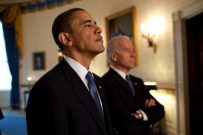Obama's Nod to Crony Philanthropy
In his January 21 column for Forbes (“Obama’s SOTU Surprise: A Break for Charity”) Manhattan Institute Vice President Howard Husock speculates that the Obama Administration may at last be coming round to better appreciate the role of philanthropy in American flourishing. The Obama Administration is now proposing to shrink the “trust fund loophole” in favor of nonprofits, meaning that heirs would be subject to capital gains taxes on the original basis of the assets while charities would not.
Husock writes:
By proposing . . . to maintain the “stepped-up basis” rule for assets inherited by charitable non-profits, the White House has made a key concession: charities can make use of capital at least as well as Washington. Some of us, of course, think charities . . . are, at the very least, a key complement to government, and, in many cases, a better alternative. In a modest but significant way, President Obama’s State of the Union surprise shows he may agree.
Call this observer highly skeptical. What the proposal reflects instead is a consistent attack by the Obama Administration on the freedom of Americans to make decisions about how best to use the property they work hard to accrue during their lifetimes.
According to a May 2013 report by the Congressional Budget Office, the exclusion of capital gains on assets transferred at death resulted in a “tax expenditure” of about $50 billion in 2013. This expenditure represents less than one half of one percent of the more than $1.2 trillion in discretionary spending requested by Federal government agencies for FY2014.
$50 billion is less than 0.003 of the total outstanding public debt of the United States, which now tops $18 trillion. Perhaps $50 billion would, however, put a big dent in the annual interest bill for the Federal debt, which according to U. S. Treasury data exceeded $430.8 billion for FY2014? Not by a long shot. Closing the “trust fund loophole” without exception and applying all additional revenues realized thereby, would fund less than two months of interest on the Federal debt.
Let’s look at the numbers in a different context. According to Giving USA, Americans gave more than $335 billion to charity in 2013. An additional $50 billion for charity in a year could make a difference in the sector, and philanthropy advocates from both sides of the political aisle are celebrating what they believe to be President Obama’s change of mind about the value of these organizations.
There are hard questions, however, that should be asked before we can agree that there is merit in government tax policy that incentivizes the movement of billions of dollars to charities and away from individuals (many of whom are likely to reinvest most of those funds in capital markets). Let me suggest just a few we should be discussing:
1) Is the nonprofit sector truly “independent” from government?
Husock suggests that President Obama is conceding that charities can make use of capital at least as well or better than government can. But this is to mistake government spending as a legitimate “use of capital,” which is a problematic assumption. Moreover, it suggests that President Obama actually sees a distinction between government and nonprofit activity, which seems highly unlikely.
Does President Obama truly consider not-for-profit organizations as independent agents of civil society? Or does he view them primarily as extensions of Federal agencies and thus arms of Federal policy?
The influential theory of nonprofit sector economics proposed by Johns Hopkins University Professor Lester Salamon actually makes the case that nonprofits are in fact the extended arms of government. In a paper published in 2000, Salamon and his co-authors report that a cross cultural comparison of nonprofits in 22 countries revealed that the “major sources of nonprofit income . . . are fees [49 percent] and public support [40 percent],” while “private philanthropy . . . constitutes only 11 percent of total nonprofit income.”[1]
Looking at American philanthropy, an Urban Institute report of October 2014 confirms that “combining government contracts and grants into a single category, the government provided nearly one-third (32.3 percent) of 2012 nonprofit revenues.”
Such empirical data has led Salamon to challenge the “paradigm of conflict” of classical economics, which explained the existence of nonprofit entities as a response to the failure of government to supply public goods that some part of a population desired and organized outside of government to provide. Salamon proposes instead an “interdependence theory” that sees the possibility of the nonprofit sector and the state developing close cooperative relationships, depending upon a complex mix of social factors. Presumably, in (classical) liberal political societies philanthropy will be more important to the revenue and goals of the nonprofit organizations, while in a culture with more social democratic values and institutions, there will be much more interdependence between the state and the nonprofit sector.
In the U.S., where the rapidly expanding welfare state is evidence that classical liberal approaches to public policy have been giving way to social democratic approaches, it is clear to see that the relationships between the state and the nonprofit sector have grown more cooperative and more entwined over the past century.
Today, the nonprofit sector even courts closer relationships with government, not merely in pursing government grants and lobbying for increasing social welfare expenditures, but also through increasing calls for “greenlining.” Here it seeks to apply aspirations for “racial justice” to the nonprofit sector by empowering government to mandate racially diverse representation on charitable boards, and for more favorable tax treatment for charities that address poverty and social justice concerns (as opposed to those that support elite consumption and club goods such as their local school foundations, opera, museums, and other interests supposedly held only by the wealthy).
While a few conservative, libertarian, and religious donors may be jealous for the old Tocquevillean independence of civil society in America, much of the nonprofit sector is happy with its privileged tax treatment, its intertwined existence with government, and aspires to greater influence in setting social policy.
2) Does the nonprofit sector actually produce more bang for the buck than the same dollar would in the commercial sector?
Hardly.
Despite recent claims by nonprofit advocates that dollars given to charity can generate huge multipliers in economic impact, it’s a difficult claim to sustain. On the whole, the nonprofit sector would seem to fall short of the commercial sector in at least two key areas of economic productivity: employment and capital investment.
During the recent recession, nonprofit analysts pointed to the growth of nonprofit employment as a sign that nonprofits can contribute to economic growth. The economic modeling used to support these claims depends on the same sort of Keynesian analysis that supports government spending to sustain employment and consumer spending during economic downturns. Public policies built on such Keynesian principles have been tried and found largely ineffective in pulling economies out of recessions. More jobs does not equate to better jobs, and it is unlikely that nonprofit employment is a preferable substitute for industrial and commercial employment.
Nonprofits are also not the ideal vehicles for capital investment. The point of being NOT-for-profit suggests that dollars entering the nonprofit economy will be used for supplying consumption goods and services rather than for increasing capital. This is not a flaw of nonprofits but a feature, and yet it in no way supports the conclusion that nonprofits are economically preferable to commercial enterprises.
There is a positive and important role for charitable organizations in American civil society. Charitable organizations can strategically use philanthropic dollars to help individuals rebound from the unexpected shocks of life, from catastrophic illness to the creative destruction of industrial evolution. Scholarships for individuals and investments in health, education, and welfare programs can help people expand their education, training and opportunities. Philanthropy can even help whole communities suffering from the destruction of natural disasters or the abandonment of industrial factories rebuild, retool, and find new ways to contribute value to and gain value from the extended market order.
In the long run, however, despite our romantic wishes, it is savings and capital investment—the business of business—that enables the production of food, shelter, clothing and other amenities of life on a scale to meet the needs of billions of people. Capitalism, not philanthropy, is the high octane that fuels economic prosperity and establishes the most fundamental conditions of human dignity, out of which the humane goods of education, aesthetic creation, recreation, leisure, compassion and generosity can grow.
3) Is tax policy all that effective at generating positive social outcomes?
With a few exceptions, partisans of all stripes seem to view the charitable deduction as sacrosanct. But the deduction itself is a product of big government. Politicians created it to ameliorate the drastic consequences for private giving of the unprecedented federal income tax enacted in 1913 and the extremely progressive rates being proposed by Congress in the War Revenue Bill of 1917 (more on this below).
On the challenges of using tax policy as a tool of social engineering, it is worth quoting at length the May 2013 CBO Report cited above, the full title of which is “The Distribution of Major Tax Expenditures in the Individual Income Tax System”:
The provisions of law that lead to tax expenditures are generally designed to further societal goals. For example, the tax expenditures for health insurance costs, pension contributions, and mortgage interest payments may help to promote a healthier population, adequate financial resources for retirement and greater national saving, and stable communities of homeowners. However, tax expenditures have a broad range of effects that do not always further societal goals.
First, tax expenditures may lead to an inefficient allocation of economic resources by encouraging more consumption of goods and services receiving preferential treatment; they also may subsidize activity that would have taken place without the tax incentives. For example, the tax expenditures mentioned above may prompt people to be less cost-conscious in their use of health care services than they would be in the absence of the tax expenditure for health insurance costs; to reallocate existing savings from accounts that are not tax-preferred to retirement accounts, rather than add to their savings; and to purchase more expensive homes, investing too much in housing and too little elsewhere relative to what they would do if all investments were treated equally.
Second, by providing benefits to specific activities, entities, or groups of people, tax expenditures increase the size and scope of federal involvement in the economy. Indeed, adding tax expenditures to conventional federal outlays makes the federal government appear notably larger relative to GDP. (CBO Report, 7)
So, What’s the Point?
If $50 billion is not that much money in the big picture; if the Obama Administration is unlikely to view philanthropy as a substitute for government; if a philanthropic dollar is likely to be much less economically productive than the same dollar turned into capital investment; and if tax policy is not the ideal path to realizing social justice, what’s the real target of the proposal to make charities the only beneficiary of the “trust fund loophole”?
My guess is that this proposal has a lot less to do with the President’s view of philanthropy than it has to do with his view of social justice. It thus has less to do with the value of the tax expenditure and the alternative uses to which those dollars could be put and more to do with the distribution of the expenditure, that is, who benefits most from it.
According to the CBO:
65 percent of the tax benefit accrues to the top quintile (with 21 percent going to the top 1 percent of households), and an additional 17 percent accrues to the fourth quintile. The exclusion of capital gains at death largely benefits households with high net worth, and such households tend to be in the upper portion of the income distribution.
In other words, this proposal is part of the ongoing attack on prosperous Americans. It is also a tacit compact of extortion between advocates of social democracy in the Administration and the advocates of social justice in the nonprofit sector. Closing the loophole in the way proposed by President Obama would primarily benefit those who already comprise the strongest lobby for greater redistribution of wealth in America. Either the wealthy leave their highly appreciated assets to charity, or their heirs must eventually lose large portions of their inherited property to taxation.
Despite its rhetorical jujitsu, which leaves conservative defenders of philanthropic freedom applauding, the proposal under discussion is at bottom an attack on the whole meaning of property. It is class warfare and creeping statism, perpetuated by all means that can be found.
It is not an olive branch for philanthropy, for where property is dead, there can be no philanthropy.
Husock and other advocates of the role of philanthropy and nonprofits in American society who may wish to look favorably on the protection of charitable bequests from the elimination of the “stepped up basis” may find it easy to cheer a public policy that could encourage up to $50 billion more in gifts to the charitable organizations for which so many of these advocates work. But doesn’t this reek of the sort of rent-seeking behavior for which “crony” capitalists have come under fire?
Husock has written insightfully on the dangers of crony philanthropy, so I don’t believe he’s ignorant of the problems of rent-seeking in general. But I want to encourage him to carry his thinking to deeper levels by applying the broader tools of public choice scholarship and constitutional political economy pioneered by scholars such as Vincent and Elinor Ostrom, James Buchanan, and Gordon Tullock. Their work is indispensable to the tasks ahead, which begin with getting our questions right.
Those who wish to defend the classical liberal foundations enshrined in the Constitutional protections of the lives, liberties and property of American citizens have work to do. Social democracies around the world are proving fiscally unsustainable, and America needs tax and budget reform to move us off this path.
One of the first tasks we must undertake is to clear the air of our romance with the charitable deduction and to better understand the history and evolution of Federal tax policy in the U.S. since the enactment of the Sixteenth Amendment in 1913. Before America can embark on a serious conversation about meaningful tax and budget reform, we have to look hard even at sacred cows such as the charitable deduction and the federal tax exemption for charitable and educational organizations. This history discloses that the charitable deduction and exemption opened the door to a significant incursion of government into the philanthropic sector.
The introduction of the charitable deduction came about because colleges and universities realized that the steeply progressive wartime tax on America’s wealthiest citizens being proposed by Congress in 1917 would decimate their revenues. At that time, when education was still largely a matter of state and local policy and philanthropic enterprise, colleges still depended heavily on private philanthropy rather than streams of government funding from Washington for revenue.
When higher education leaders shook hands with politicians to carve out special tax treatment to protect the revenues of their own institutions, the deal exemplified how special pleading for Congressional favors could work in the name of a good cause and thus contributed to the death of property in America.
What is property but the possession and the use of that which we possess, regardless of the broader social (justice) policies of those around us? If I forego the use of my property for sumptuary living and instead save it to meet the future needs of my family and/or invest it for economic increase, should I then be barred from distributing that same property and its increase to any heirs I choose, whether family or charity? Should the government instruct me that giving a gift to charity rather than providing for the college education and future of my children or grandchildren is a preferable or better use of my property?
If we believe it is the role of government to transcend the Constitutional protections of property, even in the name of philanthropy, then we must mourn, “Property, the bulwark of American liberty, ask not for whom the bell tolls, it tolls for thee.”
[1] Lester M. Salamon, S. Wojciech Sokolowski, and Helmut K. Anheier. “Social Origins of Civil Society: An Overview.” Working Paper of The Johns Hopkins Comparative Nonprofit Sector Project, December 2000.




